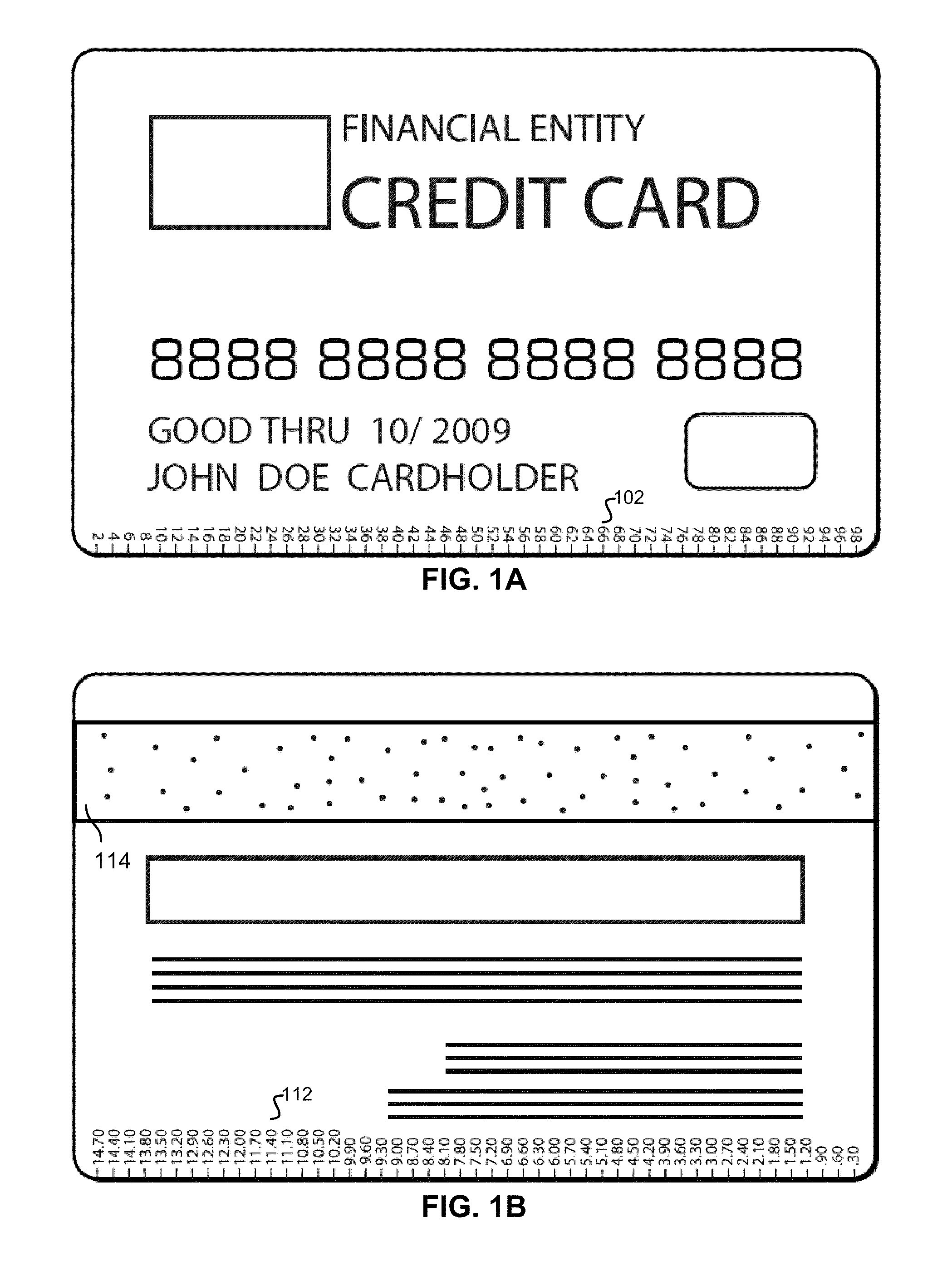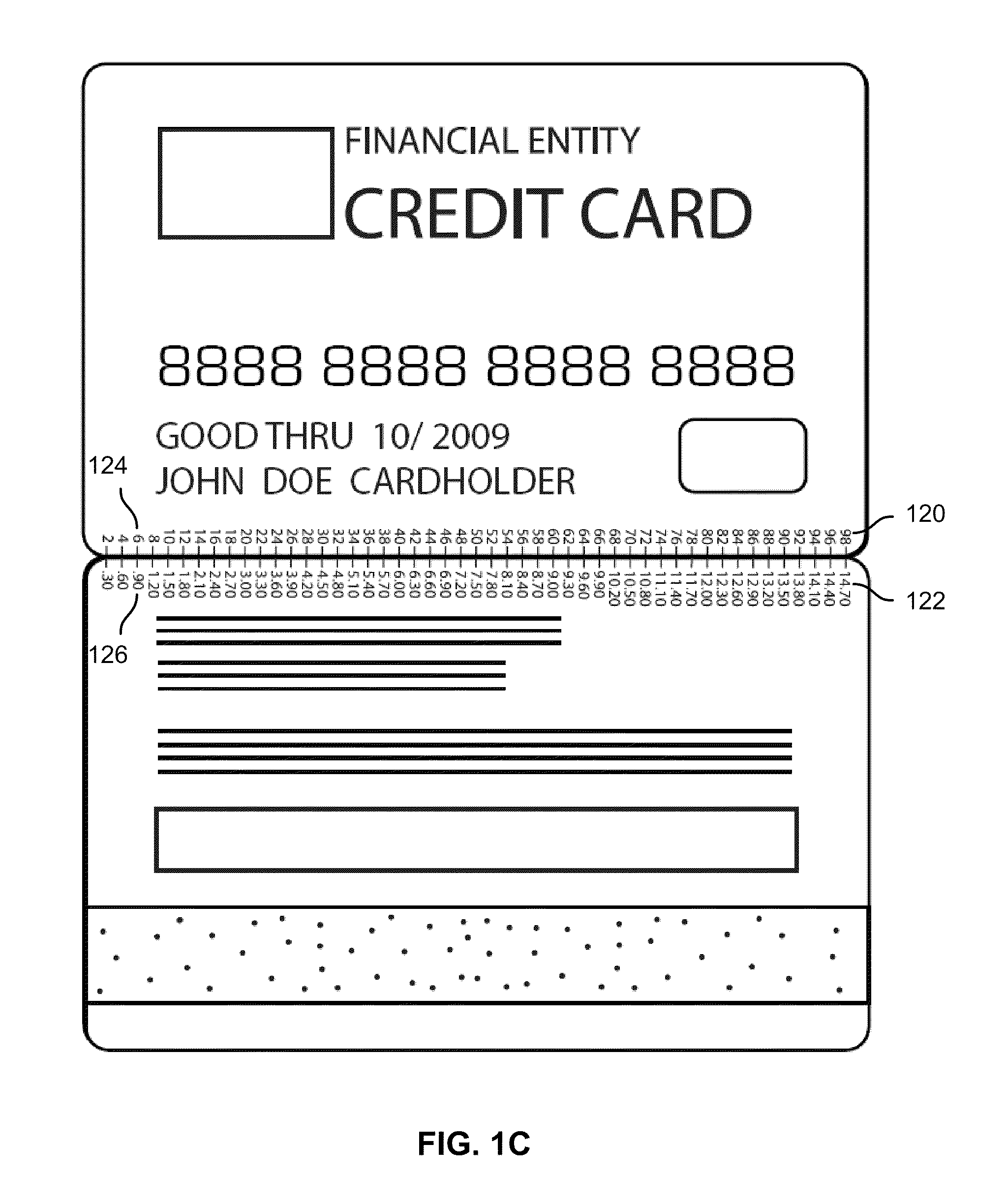Transaction card with three-dimensional tipping guide
a tipping guide and card technology, applied in the field of three-dimensional tipping guide for cards, can solve the problems of patrons and customers to under-tip, over-tip, calculate incorrectly, over-tip or under-tip out of uncertainty,
- Summary
- Abstract
- Description
- Claims
- Application Information
AI Technical Summary
Problems solved by technology
Method used
Image
Examples
example 1
A consumer named James uses a credit card with incorporated tipping guide in an upscale cocktail bar after he receives his bill. He views his credit card by inconspicuously holding the credit card with two fingers (see FIG. 12A) and quickly slides his thumb along the outer area of the credit card to match the cost of his bill (see FIG. 12B). At the appropriate cost-representative number (i.e., the cost-representative number matching the cost of the bill), he places his thumb underneath that number on the front of the credit card and places his index finger at the same place on the back of the card (see FIG. 12C). James then views the cost-representative number (see FIG. 12D). Now James quickly flips the card over (see FIG. 12E) to view the gratuity number which represents the desired percentage of the cost-representative number (i.e., the actual cost of the service or item rounded to the nearest number that is divisible by 10) (see FIG. 12F). Briefly, James views the appropriate gra...
example 2
In another example, Jill Doe who works as a physician in a hospital carries her employee badge all day due to hospital restrictions. During her lunch hour, Jill frequently visits the hospital cafeteria, and if time permits, the neighboring medical museum where lunch tours are led by self-employed tour guides on commission. Jill has a tipping guide incorporated into her employee badge holder (1602) that holds her hospital identification card (1604). The tipping guide appears along the outer edges or outer areas of the badge above the rubberized edge such that Jill can conveniently calculate a tip when she visits the cafeteria where she lunches and then the museum where she takes part in guided tours. Suppose visitors to the museum are expected to pay at least a 30% tip on top of the museum admission price and that admission to the museum costs $6.00. Jill is able to determine that a minimum tip of $1.80 should be paid to the guide by sliding her thumb along the cost-representative nu...
example 3
In another example, Sandrine, an actress and ballerina, is a star in a Broadway show. The theater has tight security due to overzealous fans and every actor carries a security card that doubles as an access card to enter the secured theater building. Sandrine has numerous assistants and helpers to get ready for each show due to her lavish costumes that change after every scene in which she appears during the play. When Sandrine is not dancing on stage she moves about the theater and carries her security or access card that incorporates a tipping guide along the outer edges or outer areas of the card. In addition, the card with tipping guide includes a dial and attached pointer that assists Sandrine in determining tips (see FIGS. 9A and 9B). Since Sandrine is a bit short-sighted and unable to see perfectly without glasses or contact lenses she appreciates the plastic dial and pointer that help her determine a tip quickly and easily. Sandrine uses her tipping guide throughout the day ...
PUM
 Login to View More
Login to View More Abstract
Description
Claims
Application Information
 Login to View More
Login to View More - R&D
- Intellectual Property
- Life Sciences
- Materials
- Tech Scout
- Unparalleled Data Quality
- Higher Quality Content
- 60% Fewer Hallucinations
Browse by: Latest US Patents, China's latest patents, Technical Efficacy Thesaurus, Application Domain, Technology Topic, Popular Technical Reports.
© 2025 PatSnap. All rights reserved.Legal|Privacy policy|Modern Slavery Act Transparency Statement|Sitemap|About US| Contact US: help@patsnap.com



